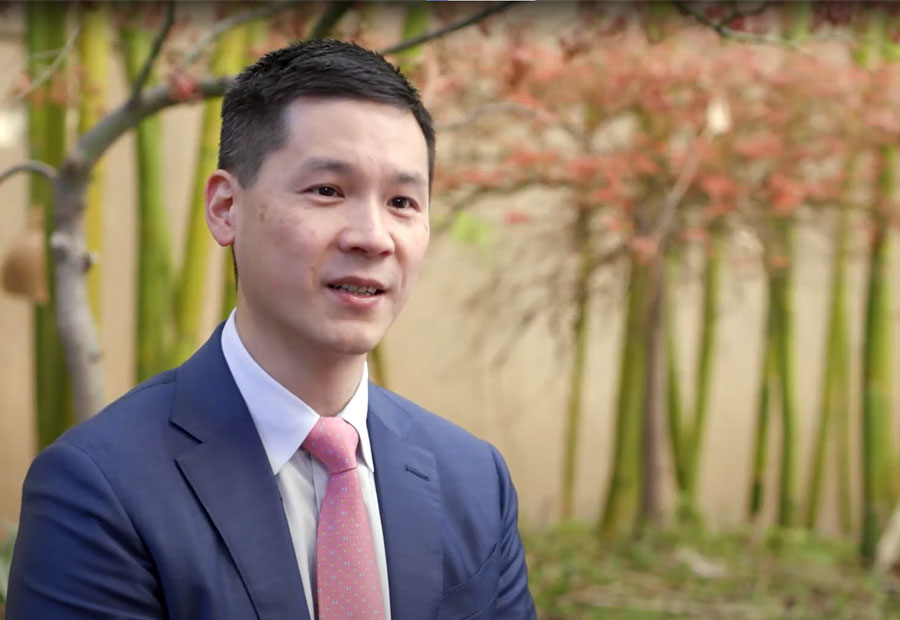Acoustic Neuroma (Vestibular Schwannomas)
Acoustic neuromas (also called vestibular schwannomas) are noncancerous brain tumors that can cause problems with hearing, balance, and facial movement and sensation. Even though vestibular schwannomas are not cancerous, it's important to get the right treatment so you can maintain your quality of life.
At Stanford Health Care, we're leaders in treating all sizes and types of acoustic neuromas, no matter how common or complex. People from around the world come to us for our multispecialty team, advanced treatment options, and compassionate care.
Overview
What is an acoustic neuroma (vestibular schwannoma)?
An acoustic neuroma is a noncancerous tumor that grows on the vestibular nerve, which connects the inner ear to the brain. This nerve sends hearing and balance information to the brain. As the tumor grows, it can disrupt those functions and facial movement and sensation, in some cases.
Acoustic neuromas are rare, affecting one in 100,000 people in the United States each year. These tumors are usually diagnosed in adults in one ear and are not hereditary. Vestibular schwannomas are similar to acoustic neuromas but are rarer still. They can affect both ears or be associated with other benign growths in connection with a genetic disease called neurofibromatosis-2. The tumors usually grow slowly.
Diagram of an acoustic neuroma
Left: This cross-section diagram of the skull base shows a small acoustic neuroma (vestibular schwannoma) on the right side of the head. The tumor develops on the vestibular nerve, which sends hearing and balance information from the inner ear to the brain. The tumor's volume fills the inner bony ear canal (internal auditory canal) and extends to the trigeminal nerve, regulating facial movement and feeling.
Right: When the acoustic neuroma grows larger, as shown here, it enters the space between the inner ear canal and brainstem. This large tumor pushes on the brainstem, cerebellum, and trigeminal nerve, affecting facial functions.
Connect to Care
Let us help find personalized care options for you and your family.
Understanding Acoustic Neuromas
Acoustic Neuroma Symptoms
You may not notice vestibular schwannomas symptoms right away because these tumors usually grow slowly, and symptoms may develop gradually. When a tumor becomes large, it can cause:
- Hearing loss or ringing in one ear
- Dizziness or difficulty with balance
- Facial numbness, weakness, or a twitch
- Headache, confusion, difficulty swallowing, or tingling when bending the neck
Acoustic Neuroma Risk Factors
In most cases, we don't know what causes acoustic neuromas. However, some factors may increase your risk, including:
- Prior radiation therapy
- An inherited genetic condition called neurofibromatosis type 2, which can cause cells to grow out of control and can lead to cancer.
Diagnostic Tests for Acoustic Neuroma
Doctors use a neurological exam to diagnose an acoustic neuroma. During this exam, your doctor looks for changes to your hearing and balance. These changes can be signs of a tumor.
Imaging tests that take pictures of your brain and the areas around it also help diagnose an acoustic neuroma. Doctors use a variety of imaging technologies, each offering different insights to confirm the presence and location of a tumor.
- MRI to diagnose an acoustic neuroma: Our doctors prefer to use magnetic resonance imaging (MRI) to confirm the presence of an acoustic neuroma. This test uses radio waves and magnets to create images of brain structures. A technologist or nurse may perform this scan by injecting contrast dye into your arm to illuminate the tumor’s location.
- CT scan to diagnose acoustic neuroma: Some people cannot have an MRI because the magnets interfere with implanted medical devices such as pacemakers and cochlear implants. Computed tomography (CT) scans combine multiple X-rays and provide doctors with another way to see structures in the brain. They can miss small tumors, however.
Acoustic Neuroma (Vestibular Schwannoma)
Our neurology specialists are experts in caring for acoustic neuroma brain tumors (vestibular schwannomas) with advanced diagnostic and treatment options.
acoustic neuroma
vestibular schwannoma
acoustic neuroma symptoms
acoustic neuroma surgery
vestibular schwannoma symptoms


